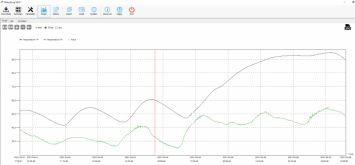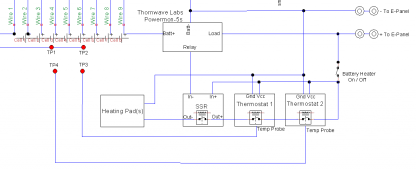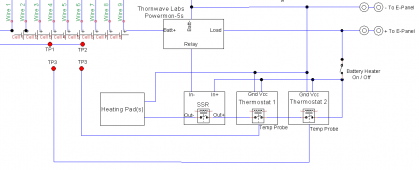The issue with a single MPPT is the pretty large difference in charge profile for the LFP and parallel lead-acid batteries. That's why charge I'm recommending a smaller and cheaper add-on solar controller, with its own battery. The heater circuit is attached to that battery, with both the 'only-in-low-temperature' and another "night-time-shutoff" device inline on the +12v supply line into the heater pad(s). That shutoff device could be the smallest of the Victron "battery-protect" devices, programmed all the way up to Mode-8 on the programming display. (12.0 Volts disconnect, 13.0 Volts reconnect.) That would pretty much assure that the heater pads are only run when the "smaller and cheaper" MPPT is providing at least "float mode" charge voltage into the battery -- which can only happen in the daytime.

Whether a cheap PWM could handle that incoming voltage, with only a "small" lead-acid battery to handle the huge difference between connected and disconnected Voltage, is an open question, and the answer is probably "No". When an MPPT runs in PWM mode, it still has the "huge" inductor (be it electronic or physical) to smooth out the input side - and a basic PWM doesn't have that. But it sounds like you already have two MMPT controllers on hand - the Victron and the Outback. Why not dedicate the smaller to the new lead-acid battery and heater circuit? They can share the Solar input array - whether one is disconnected or not (internal to the MPPT) is an internal micro-decision of the Controller, and the desired battery output Voltage is a matter of your own programming.
We still have the problem of switching the path of "PV +" into the LFP-dedicated array, but I still make a SWAG that a Relay with 36-VDC coil, sitting right on the "PV +" input, would handle the 45-48 disconnect Voltage withouth problems.
- - -
Complex side note: In my travel trailer with LFP batteries, the "trailer battery charge" wire in the Bargman connector (from the tow vehicle) can run at either "under-the hood" operating voltage (typically 13.4 - 1.42 volts, depending on the state of the TV starter battery) - or at a regulated 36 volts, through a DC boost 12V -> 36V converter-regulator. This is under the control of a dashboard within the TV. Within the Trailer, and switching automatically, "PV +" is connected to the Tow Vehicle when the Voltage on that line exceeds approximately "24 Volts", and remains connected until Voltage on that wire drops below about 18V (the minimum "hold-in" Voltage of an activated "24 Volt" Relay coil). That 24-volt Relay is subjected to 36 volts and held in ALL THE TIME while I tow the Trailer with this Tow Vehicle - because the 430 watts being provided by the Tow Vehicle in "36 volt mode" is more than I get from the genuine panels, except near Solar Noon on a cloudless day.
- - -
But, now that I reconsider, you don't actually need a "36 volt" relay at all. Your "PV +" input from the panels is split into the two MPPT controllers, but the big one (for the LFP batteries) is only "enabled" when the main "thermostat relay" is NOT calling for heater activation. It doesn't matter if "PV +" is active into the LFP batteries when the temperature of the battery pack is good - even at night. It only matters that "PV +" into the LFP charger be disconnected when the battery pack is too cold.
The switched "power" Voltage can be zero, or 48 volts. (Or 'whatever', most of these Relays can handle more than 60 Volts of difference between "connected" and "disconnected". Some can handle more than 200 Volts). The COIL voltage need only be 12v abled/disabled from the thermostat relay output.








